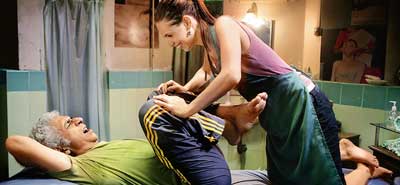
| Previews | ||
| mumbaimirror.com Return of parallel cinema October 31, 2010 |
||
This past week I got a taste of the peak period of the new wave cinema movement of the 1980s, and then was brought back to the present times with a new indie film. Some people may find the transition a rude shock, although for me it was a thrilling experience.
The week closed with a screening of a new indie film – Anurag Kashyap’s That Girl in Yellow Boots, the opening night event at New York’s South Asian International Film Festival. An exploration of the seedy side of Mumbai, the film features Kalki Koechlin, as a British girl in search of her father. Watching these films made me think about how good the times were during the heyday of the new wave movement, when an amazing collection of the socially conscious films were produced, often staring Azmi, Patil, Naseeruddin Shah (he is in both Khandhar and Mirch Masala), Om Puri and Deepti Naval. The films were usually financed by the National Film Development Corporation (NFDC). There was a lot of excitement around the new wave movement that started with Mrinal Sen’s Hindi film Bhuvam Shome (1969). In a period of 10-15 years, Indian cinema went through a significant upheaval. But despite winning national awards and film festival invitations, very few of these films got theatrical distribution. The new wave movement started as a reaction to the Indian commercial films, but it never became the sustainable parallel cinema that critics and some filmmakers had hoped for. The movement eventually lost its steam and died a slow death as commercial cinema continued to thrive. The decade plus of Hindi commercial films now dubbed as Bollywood and often produced as a commodity aimed at the global Indian, gave an organic impetus for the emergence of the current indie cinema. Many observers have remarked that 2010 has been a banner year for strong indie films including Yellow Boots, Ishqiya, Udaan, Peepli (Live), Vihir, Love, Sex Times Wellness http://www.timeswellness.com Aur Dhoka, Harud. Yellow Boots also bridged the gap with the new wave films of 1980s. Kashyap had to seek part funding from NFDC for post-production work. Some things have changed. Yellow Boots received an adults certificate but with no censor board mandated cuts. In the early 1980s a more conservative censor board would have probably banned the film for its sexual and violence content. These days, NFDC is a small player and young filmmakers are seeking private sources to fund their films. There is also the issue of influences. Khandhar’s meditative, spiritual style has been compared with the works of the French master Robert Bresson, but the new wave films were generally rooted in Indian traditions. The influence of the European and other world cinema is much more implicit in the current indie films. The emotional feel of Yellow Boots, with the rich atmospheric cinematography, colours and music is very similar to works by Fatih Akin (Head-On) and Wong Kar-wai (Happy Together). But despite the multiplexes in India , distribution options for the indie films remain limited. Udaan, Vihir had very weak theatrical distribution in India . Harud and Yellow Boots have yet to open. Bela Negi’s acclaimed Daayen ya Baayen opened this week with no promotion. In Delhi the film is playing one show a day, in a single theatre. Today’s indie films are here to stay. I do not believe they will vanish like the earlier new wave movement. But the road ahead continues to look bumpy.
|
||
| Source: http://www.mumbaimirror.com/article/54/201010312010103102452687518f7fdb8/Return-of-parallel-cinema.html | ||
